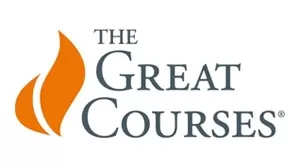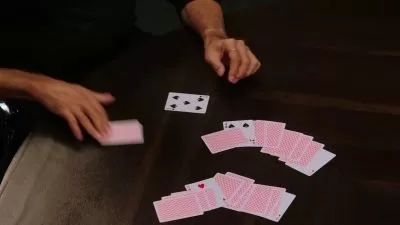Math and Magic
Arthur T. Benjamin
6:28:01
Description
Try this: Arrange an ordinary deck of cards so that the colors alternate red-black, red-black, all the way through. Now have someone cut the deck as many times as they like. Deal off a stack of cards, one card at a time, that roughly divides the pack in two. Invite someone to shuffle the two stacks together. Then deal cards from the top in pairs. Your audience will be astonished that every pair has a red card and a black card. How can that be?
Nothing can amaze quite like an expertly-executed magic trick. Ideally, only the magician knows how truly simple the deception is. After watching Math and Magic, you will know that this trick and its many variants rely on a remarkable property of patterned sequences called Gilbreath's principle—named after an amateur magician who was also a mathematician. Magic is full of such wonders, as you discover in these 12 illuminating half-hour lessons presented by one of The Great Course's most popular lecturers: award-winning Professor of Mathematics Arthur T. Benjamin of Harvey Mudd College, who is himself a professional magician.
Renowned in TED Talks, The Colbert Report, and other popular media as a “mathemagician,” Professor Benjamin teaches you the techniques and secrets behind dozens of great math-based tricks. Even if you are a numerical novice, you will look like a prodigy after mastering these math-inspired showpieces, which require no skills beyond basic algebra—and a bit of showmanship.
Learn the Fundamentals of the Magician's Art
While magicians supposedly never reveal their tricks, when you learn the mathematical foundations behind how they work, you're opening your eyes to one of the most fascinating and rewarding features of their craft and it gives you a crucial advantage in a number of areas, including:
• Tricks are easier to remember if you understand how they work.
• Knowing the “why” of a trick is the gateway to new effects as well as novel variations of the original.
• Mathematical magic stimulates problem-solving skills, such as rapid mental calculation.
• Magic can lead young people to fall in love with math—as happened with many professional mathematicians when they were young.
In Math and Magic, Professor Benjamin introduces you to magic, using tools like playing cards, numbers, and geometric figures. For each trick, he first runs through a demonstration. Then, he pulls back the curtain to show how the trick is done, explaining in detail the mathematical ideas underpinning the illusion. In this way, you learn such fundamentals of the magician's art as:
• Parity principle: Promoted by magician Bob Hummer, this idea has inspired a series of tricks in which the cards are treated in pairs according to a systematic procedure. Although the cards seem to be fairly mixed, an inherent order is preserved that, when revealed, astounds spectators.
• Faro shuffle: Devised as a way to beat the popular 19th-century card game faro, this bit of trickery is also known as the perfect shuffle, in which cards from two equal halves of a deck are interlaced perfectly. A sequence of such shuffles can bring the top card to any desired position, creating a truly magical effect.
• Lightning calculations: Dr. Benjamin is famous for his ability to solve problems in his head, often faster than someone punching numbers into a calculator. Naturally, he uses shortcuts, many of which are quite simple. For example, in this course you learn an easy method for determining cube roots that will make you look like a mathematical genius.
• Magic squares: Popular for centuries, magic squares are grids of numbers where each row, column, and diagonal adds up to the same number. It might seem that only a few solutions are possible for a given grid, but that's usually not true. You can impress your audience by building a magic square based on any number, or even based on someone's birthday.
Astonish and Delight Your Friends
Throughout the lessons, Professor Benjamin teaches you how to astonish and delight your friends, family, and even yourself. In a bit of kitchen magic, he shows how to cut a bagel into two interlocking halves—a two-twist version of a Möbius strip. Among its advantages, this intriguing shape has a greater surface area than an ordinary sliced bagel and therefore holds more cream cheese!
Magic has held humans spellbound for a very long time. A few centuries ago, even simple card tricks like those in this course could have prompted accusations of witchcraft—with the result being persecution or even death. Fortunately, with Math and Magic, you don't have that worry. Your only problem will be tearing yourself away from these “bewitching” lessons.
More details
User Reviews
Rating
Arthur T. Benjamin
Instructor's CoursesDr. Arthur T. Benjamin is Professor of Mathematics at Harvey Mudd College. He earned a Ph.D. in Mathematical Sciences from Johns Hopkins University in 1989. Professor Benjamin's teaching has been honored repeatedly by the Mathematical Association of America (MAA). In 2000, he received the MAA Deborah and Franklin Tepper Haimo National Award for Distinguished College or University Teaching of Mathematics. The MAA also named Professor Benjamin the 2006-2008 George Pólya Lecturer. In 2012, Princeton Review profiled him in The Best 300 Professors. He is a professional magician, whose techniques are explained in his book Secrets of Mental Math: The Mathemagician's Guide to Lightning Calculation and Amazing Math Tricks. Professor Benjamin also served for five years as coeditor of Math Horizons magazine. An avid games player, Dr. Benjamin is a past winner of the American Backgammon Tour and has written more than 15 papers on the mathematics of games and puzzles. Professor Benjamin has appeared on dozens of television and radio programs and has been featured in publications, including Scientific American, People, and The New York Times. In 2005, Reader's Digest called him America's Best Math Whiz.

The Great Courses
View courses The Great Courses- language english
- Training sessions 12
- duration 6:28:01
- English subtitles has
- Release Date 2023/06/06












